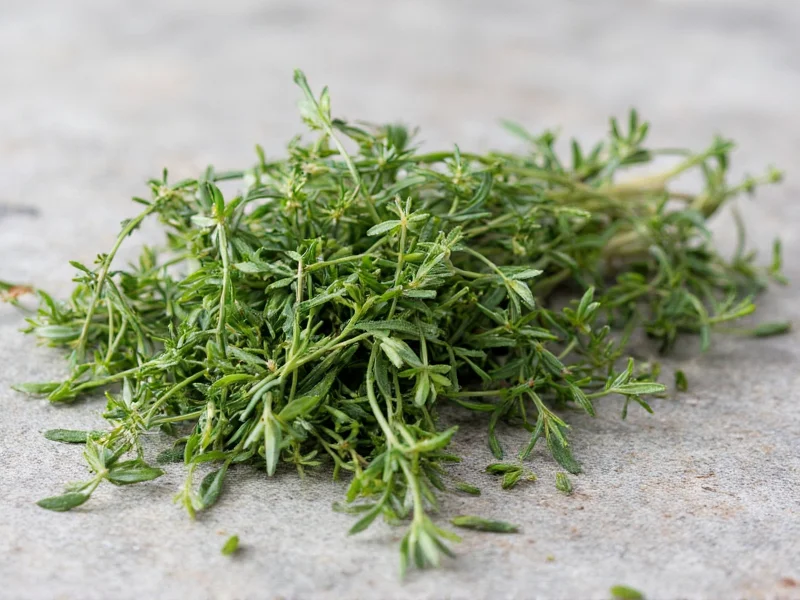A sprig of fresh thyme typically contains 4-6 inches of the woody stem with leaves attached, yielding approximately 1/4 to 1/2 teaspoon of stripped leaves. This measurement varies based on stem thickness and leaf density, making proper preparation essential for accurate recipe execution.
Understanding fresh thyme measurements is crucial for home cooks and professional chefs alike. When recipes call for sprigs fresh thyme, they're referencing a specific portion of the herb that impacts both flavor intensity and dish presentation. Unlike dried herbs, fresh thyme offers brighter, more complex notes that transform sauces, meats, and vegetables when used correctly.
What Exactly Is a Sprig of Fresh Thyme?
A sprig fresh thyme refers to a single stem segment cut from the main plant. Standard culinary practice defines this as a 4-6 inch piece containing multiple leaf clusters along a thin woody stem. The exact leaf quantity varies depending on the thyme variety and growing conditions. English thyme typically produces denser leaf coverage than lemon thyme, affecting the final measurement.
Converting Sprigs to Standard Measurements
Accurate conversion between sprigs fresh thyme and standardized measurements ensures recipe success. The following table provides reliable equivalents for common cooking scenarios:
| Sprigs of Fresh Thyme | Stripped Leaves (Teaspoons) | Dried Thyme Equivalent | Best Usage Context |
|---|---|---|---|
| 1 small sprig (3-4") | 1/4 tsp | 1/8 tsp | Delicate sauces, egg dishes |
| 1 standard sprig (4-6") | 1/2 tsp | 1/4 tsp | Most recipes, roasts, stews |
| 1 large sprig (6-8") | 3/4 tsp | 3/8 tsp | Hearty braises, game meats |
| 3-4 sprigs | 1 1/2-2 tsp | 3/4-1 tsp | Stocks, long-simmered dishes |
Proper Preparation Techniques
Correctly preparing fresh thyme sprigs maximizes flavor extraction while preventing woody stem contamination in finished dishes. Follow these professional techniques:
- Washing: Rinse sprigs under cool running water, gently swishing to remove dirt from leaf clusters
- Drying: Pat thoroughly with clean kitchen towels or use a salad spinner to prevent dilution of flavors
- Stripping: Hold the sprig at the top and run your fingers downward against the grain to remove leaves efficiently
- Chopping: For even distribution, finely mince stripped leaves with a sharp chef's knife
When recipes specify "add thyme sprigs whole," this typically indicates the dish will benefit from slow flavor infusion during cooking, with stems removed before serving. This technique works exceptionally well for stocks, braises, and slow-cooked meats where the woody stems won't become unpleasantly fibrous.
Substitution Guidance for Fresh Thyme
Understanding sprigs fresh thyme conversion becomes critical when substitutions are necessary. While fresh herbs always provide superior flavor, these alternatives maintain recipe integrity:
- Dried thyme: Use half the amount of fresh (1 tsp dried = 2 tsp fresh)
- Other fresh herbs: Rosemary (stronger, use 3/4 amount), oregano (milder, use 1 1/4 amount)
- Thyme-infused oil: 1 tsp oil replaces 1 sprig in sautéing applications
- Frozen thyme: Use same measurement as fresh but add 1-2 minutes to cooking time
For recipes specifically calling for "sprigs fresh thyme to garnish," never substitute dried herbs. The visual presentation and aromatic release when served whole cannot be replicated with other forms.
Optimal Storage Methods
Preserving the delicate flavor compounds in fresh thyme sprigs requires proper storage techniques. Unlike many herbs, thyme maintains quality longer when stored correctly:
- Short-term (1-2 weeks): Trim stem ends, place in glass with 1" water, cover loosely with plastic bag, refrigerate
- Medium-term (3-4 weeks): Wrap in slightly damp paper towel, store in airtight container in vegetable drawer
- Long-term (6+ months): Freeze whole sprigs in olive oil cubes or vacuum-seal after blanching
Avoid washing thyme before storage, as excess moisture accelerates spoilage. Instead, wash only immediately before use to maintain maximum essential oil concentration.
Culinary Applications and Timing
The timing of sprigs fresh thyme addition dramatically affects flavor development. Understanding when to add thyme during cooking separates adequate dishes from exceptional ones:
- Early addition (30+ minutes cooking): Whole sprigs in stocks, braises, and long-simmered sauces
- Middle addition (10-20 minutes): Stripped leaves in tomato-based sauces and vegetable dishes
- Finish addition (last 2-3 minutes): Chopped fresh thyme in delicate sauces, eggs, or as garnish
For Mediterranean dishes requiring fresh thyme sprigs, add whole stems early to infuse base flavors, then finish with chopped fresh leaves for aromatic complexity. In French cuisine, the classic bouquet garni often includes thyme sprigs tied with bay leaf and parsley stems for easy removal.
Common Mistakes to Avoid
Even experienced cooks make errors with sprigs fresh thyme that compromise dish quality:
- Using dried thyme as 1:1 substitute - dried herbs are more concentrated
- Adding whole sprigs to finished dishes - woody stems become unpleasant to eat
- Over-chopping before cooking - releases oils too early, diminishing flavor impact
- Storing near ethylene-producing fruits - accelerates spoilage of fresh herbs
When recipes specify "remove thyme sprigs before serving," this isn't optional instruction. The woody stems become increasingly fibrous during cooking and create unpleasant texture in the final dish.
Seasonal Considerations
Fresh thyme quality varies throughout the year, affecting sprigs fresh thyme measurements and flavor intensity. Spring and early summer thyme offers the most delicate flavor, while late summer and fall harvests develop more robust, earthy notes. During winter months, greenhouse-grown thyme typically has less intense flavor than seasonal outdoor varieties.
When working with off-season fresh thyme sprigs, consider increasing the quantity by 25% to achieve equivalent flavor impact. Always taste and adjust seasoning when using thyme outside its peak growing season (May-October in most temperate climates).











 浙公网安备
33010002000092号
浙公网安备
33010002000092号 浙B2-20120091-4
浙B2-20120091-4